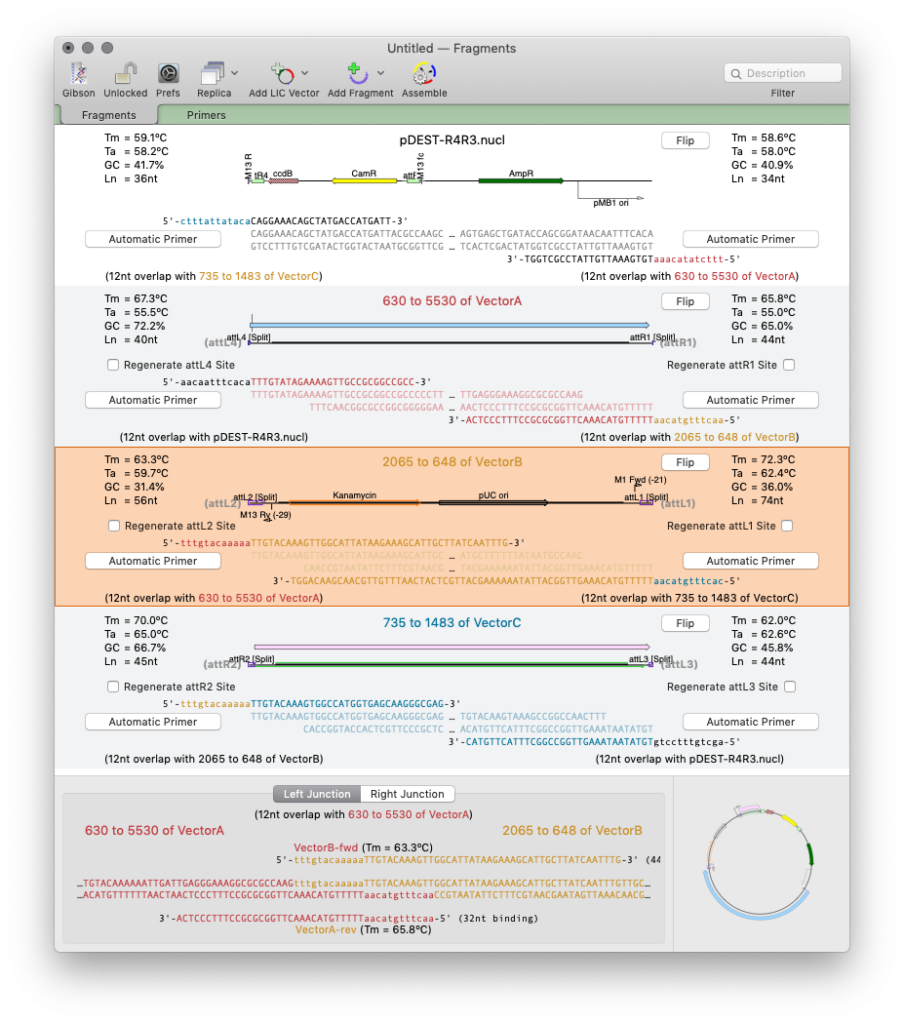Graphics
MacVector can read and write DNA and Protein sequences in most popular file formats. In addition to directly editing sequences and features/annotations, MacVector has an intuitive Click Cloning graphical interface that lets you easily replicate laboratory cloning experiments to create new molecules.
MacVector uses the Mac’s Quartz graphics to generate publication quality images that can be scaled to any size with no loss of resolution.
Cloning
MacVector supports many different cloning techniques using the Cloning Clipboard. From Gateway and Gibson Cloning/LIC to In Fusion and of course with the traditional restriction enzyme sites. Ever digest stores a fragment on the Cloning Clipboard. You can ligate fragments together on the Cloning Clipboard or just drag and drop them to your Vector to ligate into compatible sites. Once you have constructed a new vector you can design a restriction enzyme screen using the Agarose Gel window.
Gateway and Topo Cloning
MacVector supports Gateway, TOPO TA and Zero Blunt cloning technologies from Invitrogen. With a few simple clicks from an intuitive graphical interface, you can replicate your biological manipulations at the bench to create new molecules with the correct sequences across the cloning and recombination junctions.

Gibson and Ligase Independent Cloning

Auto Annotation
You can scan an unannotated or partially annotated sequence against a folder on your hard drive and MacVector will identify matching features in sequences in the target folder and add them to your sequence. Because MacVector includes custom feature appearance information when annotating the sequence, you can use this to maintain a carefully curated set of your favorite genes and sequences each with a graphical appearance that best suits your needs.
Primer Design
You can design primers for either PCR or Sequencing/Hybridization probes using a variety of primer design functions, including an interactive manual design interface along with several scanning functions such as the popular Primer3 algorithm. The interactive interface clearly shows which potential primers may have secondary structure problems, alternate binding sites or other characteristics that might impact their use in experiments.
DNA Analysis
MacVector provides a wide variety of useful DNA analysis tools, including base composition analysis, Restriction Enzyme searches, DNA Subsequence searches and “Dot-Plot” comparisons between DNA:DNA and DNA:Protein sequences. A Coding Preference toolbox lets you select a variety of algorithms to graphically scan a DNA sequence for likely protein coding open reading frames.
Protein Analysis
Protein sequences can be reverse translated into DNA, compared using “Dot-Plot” analysis and scanned for Proteolytic cleavage sites and amino acid sequence motifs. A comprehensive Protein Analysis Toolbox provides a wide variety of algorithms for analyzing the composition of proteins and presenting the results in graphical and tabular formats.
Database Searching
MacVector has built-in Internet connectivity to the NCBI BLAST and Entrez databases. You can directly search Entrez for DNA or Protein sequences based on features, authors, keywords etc and directly download them into MacVector, complete with all features and annotations. The built-in BLAST interface lets you submit multiple BLAST jobs using DNA or Protein sequences and then download any matching sequences by selecting them from a hit list. Even without an Internet connection, MacVector can align sequences against any folder on your hard drive using a FastA algorithm, allowing for “local” database searches.
Multiple Sequence Alignment
You can align unlimited numbers of DNA or Protein sequences using the ClustalW algorithm built in to MacVector. A full-featured editor lets you make manual adjustments to the alignments and view them using a wide variety of customizable color schemes. You can create publication quality graphical outputs of the alignments and view pairwise combinations of the sequences in aligned and matrix formats.
Sequence Assembly
Sequence Assembly functionality in MacVector is provided by two modules.
Align to Reference
Align To Reference can be used for two different functions, Sequence Confirmation and cDNA Alignment. This allows you to import trace files or sequence files and assemble them against a template sequence. This is ideal for small scale sequencing projects, especially resequencing. For example, checking an in situ mutagenesis experiment, a construct you’ve just made, or confirming the sequence of a cloned PCR fragment. It’s also an excellent tool for SNP analysis, with some special tools to allow you to easily spot mutations from your original template sequence.
Projects Manager
MacVector’s Projects manager has a powerful sequence assembly toolkit. It is easy to use and will manage, assemble and analyze all types of sequencing data – from Sanger reads, all types of NGS sequencing reads, to PacBio and ONT long reads. Assembler includes six different de novo assemblers, as well as two assemblers for mapping reads to reference sequence.
